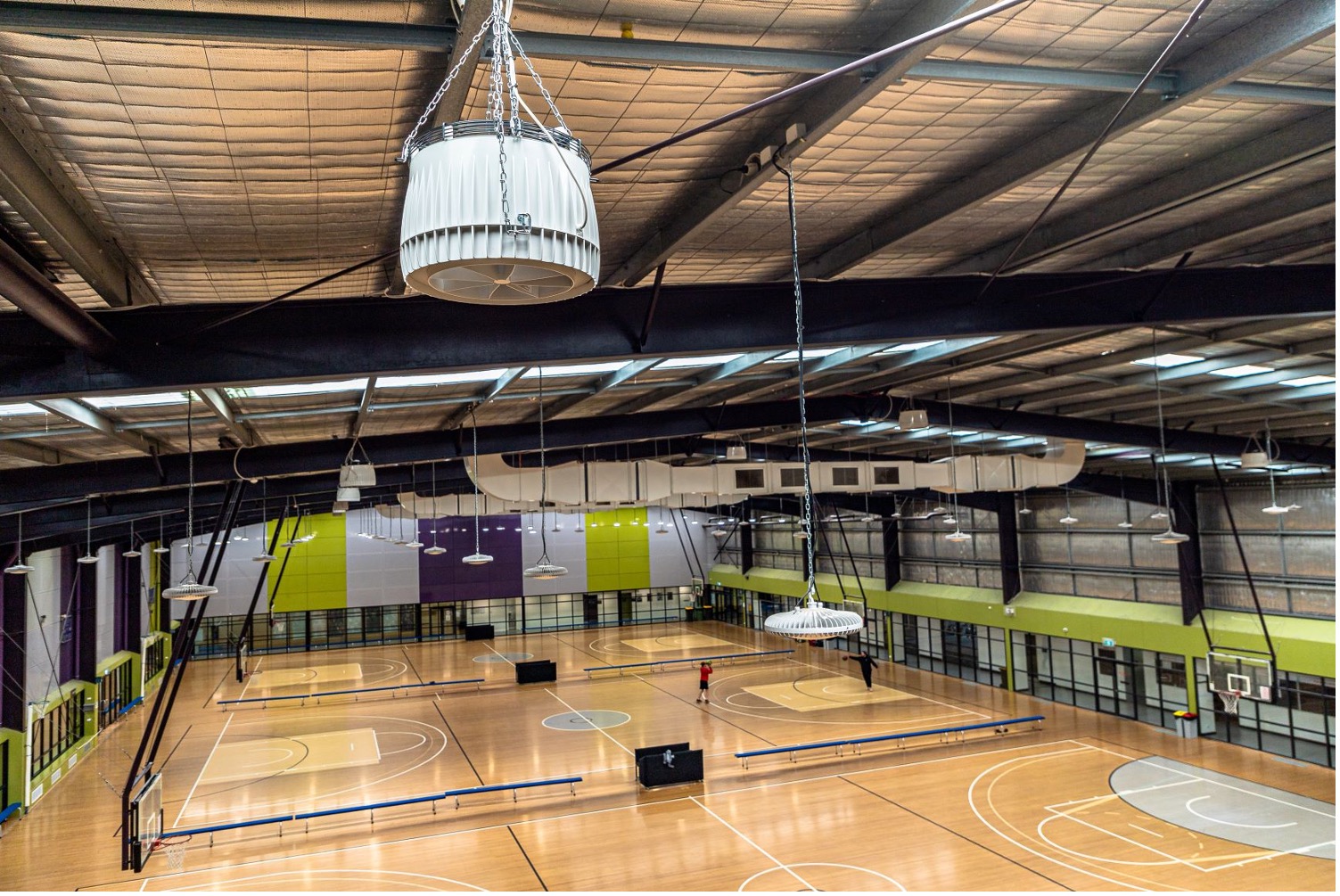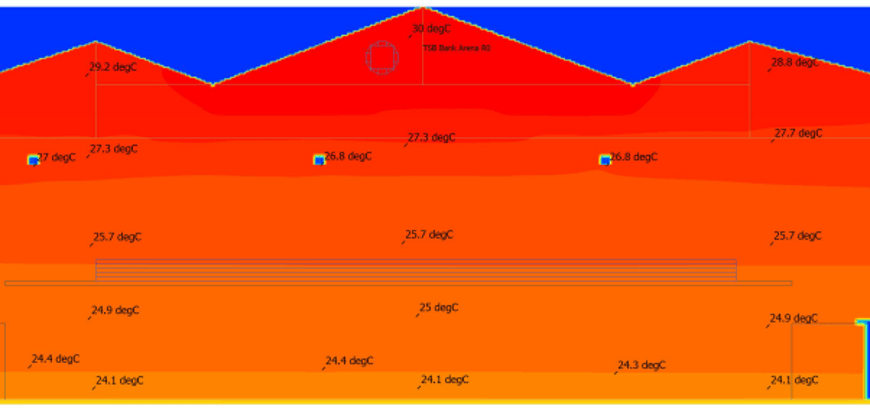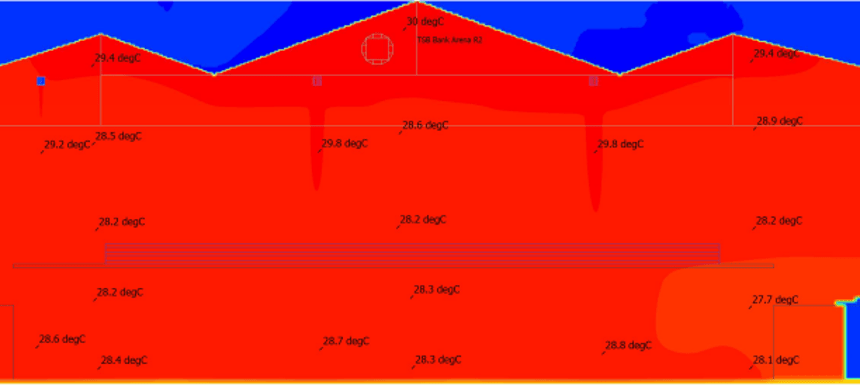
If you live in parts of Australia that have a significant heating component in your climate, heating bills can become expensive – especially if you have a larger space that you need to heat.
Southern locations such as Melbourne (6-7 months heating cycle), Sydney (5-6 months), South Australia (7 months) and Tasmania (9-months) all experience a significant portion of the year where the ambient temperature drops below what is considered “comfortable” in winter.
Generally, in Winter, thermal comfort research indicates that a room temperature of 19 -20°C is comfortable whilst wearing warmer clothing, however many prefer their space warmed up to around 23°C.
Thermal comfort is also very subjective – for example, the conditions that one person finds comfortable is often different to what someone of a different gender, age or body type will find comfortable.
It’s almost impossible to keep everyone comfortable no matter the methodology. In fact, scientific thermal comfort research indicates that there is the same ‘Percentage of People Dissatisfied’ (PPD) whether using natural ventilation or air conditioning!
Another annoying Winter comfort issue is drafts. If you have a heated room in Winter and there is noticeable air movement, the inhabitant will perceive it as a draft. This occurs most often spaces where the air temperature is at 19°C or below.
In commercial buildings, especially those with high ceilings, large amounts of heat need to be pumped into a space to reach comfortable temperatures. Generally, the supply air temperature is around 30°C with the intent to achieve around 20-22°C at just above floor level.
This means there is a lot of wasted heat sitting at the top of a room (where no-one can feel it), resulting in unnecessarily high energy costs and more carbon emissions.
When you are heating a room there are a few considerations that impact on the target of optimising comfort and reducing your heating costs and related carbon emissions.
- Building design, namely the ‘R or ‘U’ value of the roof space
- Supply air temperature
- Heating design capacity
- Occupation of inhabitants – are they sitting, walking, running, working hard etc

Airius Model 60 EC fans in a sports hall in NSW
Let’s look at these points in more detail
» Building design, namely the ‘R or ‘U’ value of the roof space
The thermal value of roof insulation, which reflect the amount of heat transfer from indoors to outdoors, has a very large impact on the loss of heat from your building to the outside in Winter.
Let’s say, for example, you are pumping 30°C of air into the building to keep the inhabitants warm and comfortable. You are aiming for a temperature of around 20-22°C at 1.5m AFFL (above finished floor level). The method of distribution can be at high or low level, it doesn’t matter.
The warm air, which is lighter than the surrounding air, is impacted by cooler air in the room. The cooler air in the room is more dense than the warm air so it falls to floor, thereby pushing or forcing the warmer air upwards till it gets trapped by the ceiling.
This is known as stratification – cold at the floor, hot at the ceiling.
Now the law of physics determines that hot goes to cold. Clearly if you are pumping 30+°C temperatures into your building to keep the space warm, it stands to reason that the outside ambient air temperature, will be much lower. In Australia that will be anywhere from -0°C in alpine and southern state regions, up to around 20°C.
The difference in the indoor supply air temperature and the outdoor ambient temperature is called the ‘Delta T’. The greater the difference between indoor and outdoor temperatures, the greater the rate of heat loss from your building to the outside. Despite the insulation levels resisting that transfer, the greater the ‘Delta T’, the faster you lose that heat.
Here’s an example
Outdoor air temperature is 5°C, and you are pumping 30°C heated air into your facility, with the aim of achieving a comfort temperature of around 20-22°C around 1.5m AFFL. The Delta T in this instance is 25°C. Now despite your assumed high level of insulation value in your roof, the rate of heat loss is going to be faster than if the ‘Delta T’ (difference) was only, for example, 15°C.
So, there you are pumping all this heat into your building, and it is all sitting up under the roof, rapidly leaving your building through the roof structure, causing you to overheat the building to achieve a comfortable temperature at what we call occupation level (i.e. 1.5m AFFL).
Solution
Reduce the Delta T in the area of the roof zone by minimising the air temperature that is sitting up under the roof. For example, make the roof air temperature 22°C with ambient air at 5°C. However, you want the building to stay warm, so isn’t that working against your desired outcome?
Well, if you don’t force that warmer air to the floor all it is doing is sitting up there, rushing to the outside, achieving nothing for your heating and costing you a lot of wasted money.
Imagine if you could continually force it all down to the floor, so your ‘Delta T’ is reduced, and your inhabitants now have the benefit of a more comfortable space? How much money could you save?
» Supply air temperature
Your supply air temperature in a commercial building is usually an engineered solution. Generally, a certain number of kilowatts of heating energy is required to heat the space. If you can’t utilise that heating energy, then you keep supplying it (or oversupplying it).
It all ends up under the roof, and you keep pouring it into the space as you aim to ensure you have that heat down at floor level, so the room is comfortable. The result: a massive waste of heat, energy and your money – and usually, an uncomfortable space too.
The other key thing to remember is that the higher the supply air temperature, the more buoyant or lighter it is. The lighter air is, the harder it is to get it to the floor.
So, to optimise heating, higher supply air temperatures are not necessarily the solution. Getting it to the floor where it is felt – where it is doing what it was meant to do – is the key.
Basic air density calculations indicate that at 20°C, air density is 4% less than at 30°C. Doesn’t sound a lot but it’s enough to make a difference to the performance of your heating system. Combined with other heat saving opportunities, it all adds up to some significant cost and carbon emissions reductions.
Solution
Reduce your supply air temperature so that it’s not so light and is easier to get to the floor. The question arises how do I effectively get that warmer lighter air to the floor and keep it there?
» Heating design capacity
Heating design involves some detailed calculations. Generally, they are calculated to ensure that the heat supplied is enough to keep people warm at 1.5m AFFL.
But is stratification ever considered in heating calculations? Does the engineer calculate the heat requirements based upon warming the whole space?
Remember, if we are pumping the warmer air into the space and it’s all sitting up under the roof, then a massive amount of warm air is required to fill that building up, so it is saturated with enough heat to ensure the occupants are comfortable down near the floor.
In a large building like halls or theatres, imagine the volume of warm air and energy you need to continually heat up and push the heated air around the space? And of course, the higher the space, the harder it is to keep warm. More cost, more plant and equipment. More wasted energy. More carbon emissions. More carbon taxes, less comfort etc.
» Activity of inhabitants – are they sitting, walking, running, working hard etc
The activity of inhabitants is key to the heating design of a building. With the space dimensions being equal, if it is an office, for example, they will require more heating than those running around in a basketball court or undertaking hard labour. In addition, the office inhabitants will find air movement a draft if the air temperature is below around 19°C. (ASHRAE 55)
So, to improve heating in the office environment, the amount of air flow must be minimum, and the temperature must be comfortable. As people aren’t moving, they aren’t generating much heat, so they will feel the chill at the same room temperature more than someone who is working physically hard or exercising etc – think a gymnasium or a sports facility.

Airius G400 EC fans in a sports hall in Victoria
Solution
Understand what the requirements of the building user is and design the heating efficiently. Will the engineer consider stratification in his heating calculations? If so, how accurate are they.
There are some methodologies for calculation of stratification levels in a building, but they are bespoke and can be quite particular about the building type and shape. Accuracy for a broad range of buildings is questionable without the use of detailed thermal and air flow modelling.
How can we fix this issue?
How can you save heating energy and optimise inhabitant comfort easily?
The key to make a significant measurable impact on your heating costs is to utilise all that warm air you are currently wasting.
The air that is sitting up under the roof doing nothing – that is called ‘stratification’ of the space. And you are paying for that wasted heat that is doing nothing and pouring out of your roof.
The key is to get that lighter warm air down to the floor. That’s called DESTRATIFICATION. But is not as simple as is sounds.
The lighter air just wants to keep going back up to the top again. The higher the building and the higher the air temperature sitting up inside that building roof, the more buoyant the air is, the harder it is to send the air back down to the floor. The general methodology to send that air to floor where it is usable, is fans. However, fans are not fans.
Airius fans were initially designed to do just that in the cold climates of USA and Europe. Their patented air turbine methodology enables the fans to force a column of the warmer lighter air down to the floor; pushing that air through the denser colder air at floor level and mixing the air where it is needed. At floor level.
This is different to the typical fan types used in destratification. Large, bladed fans struggle to push the lighter warm air through the colder layers without larger levels of air movement. They don’t have the thrust or air flow shape to successfully penetrate those colder layers with lighter warmer air. So, they effectively destratify at roof level rather than at floor level like Airius fans do. This is not an effective solution.
Other cheap copycat tube fans, with no engineering smarts comparable to those found in patented Airius fans, are also unable to penetrate the colder denser temperature layers at floor level. Their air discharge is turbulent and non-laminar, making it much less effective as their air flow pathway is spread out and lacking focus and thrust. Once the lighter air hits the denser colder air lower down, the warm air just bounces off it. No penetration is achieved. Destratification doesn’t occur. There are some great smoke tests demonstrating the ineffective result of poorly engineered fans.
Solution
To highlight the value of Airius fans in a destratification, high level heating environment, an Airius client commissioned an independent CFD analyst to mimic a 15-metre-high sports hall space in a colder climate in NZ and then we examined the results.
This sports hall had a massive stratification issue.
There was a central spine air conditioning duct running lengthways down the basketball stadium, and it was discharging heated air at 30°C. Once all the parameters were fed into the computer, the results were astounding.
Without the fans the temperature difference floor to ceiling was 5-6°C – see excerpt from CFD report below.
6 CFD SIMULATION RESULTS
6.1 Destratification fans switched off‘Figure 4 and Figure 5 show the resulting velocity and temperature contours when viewed in section midway along the building. One can see that there is very little vertical air movement. There is a distinct stratification of temperatures ranging from 24°C at floor level up to 28°C at fan level, and 30°C under the roof’.

Once the fans were installed at the lowest point of the complex pitched roof, at approximately 15 metres AFFL, the floor to ceiling difference was approximately 0.9°C.
From the CFD report by Dr Colin Allison
“Due to the improved air movement… from the Airius fans… there is now a much better temperature distribution vertically throughout the volume, ranging from 28.3°C at floor level to 29.2°C at roof level. i.e. a temperature variation of less than 1.0°C…”

So, the roof temperature was far hotter than it needed to be. Wasting your money.
The result is as follows:
- The customer could reduce the heating temperature supplied to the space because it will now be more effective at a lower temperature. This would reduce capital cost and equipment requirements and reduce carbon emissions. As carbon will become more and more taxed as we move towards 1.5 degrees reduction and agreed carbon reduction practices set by authorities are implemented, then this will also assist compliance
- The run time of the heating system will be measurably reduced as well because the thermostat at floor level will be satisfied much faster. Once again, a high level of cost savings
- Comfort will be improved as all the warm air is down at the floor. Due to the unique and patented proven design of Airius fans, this redistribution of heating can be achieved with minimal air movement, thereby optimising comfort
- Destratification occurs at floor level, where it is needed
- Plant equipment size is reduced because not as much heating or air flow through ductwork is required
- Thermostat is satisfied faster meaning less energy use
- Maintenance is reduced because plant is not running as much
- Distribution ductwork can be totally removed or minimised because the fans do the distribution at a much lower cost and energy consumption level than ductwork. This can also result in reduction of floor heights because space is not required for ductwork
What does all this mean for me as a building owner or user paying the bills?
Based upon numerous examples of energy savings and improved comfort from around the world: the higher the space, the more heating energy (and costs $$$) Airius fans can save you.
In some cases, you can see a positive ROI (Return on Investment) in as little as 3 months!
Usual heating energy savings are in the 30-60% range. That equates to a significant saving of your money!
As the fans are low cost, use very low levels of energy, are easy to retro fit, and have minimal or no maintenance requirements, they provide a simple, effective, fast payback energy saving solution.
If you have heating bills that are increasing and expensive, high maintenance costs and staff complaining about being cold for the winter, Airius fans are the perfect solution for you.
To find out more about Airius fans and how they can help you, contact our expert team on 1300 985 552.
A full copy of the independent CFD report can be sourced from Airius.





